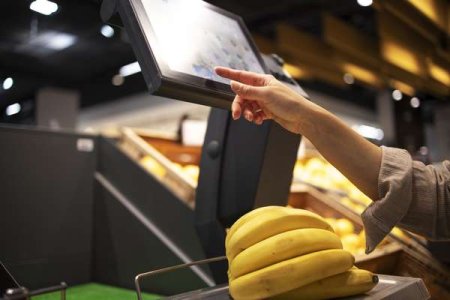Shoppers bid goodbye to supermarket frustrations with checkout update
By
Seia Ibanez
- Replies 12
You’re wheeling your trolley or carrying your basket through the supermarket, selecting the week’s groceries just like normal, but then when it comes time to check out, you start to get a little anxious over how long the queue will take.
This dreaded experience may become a thing of the past, with a revolutionary new self-service technology being trialled at United Kingdom supermarket Tesco.
Tesco is the first to trial a ‘no-scan’ checkout system that uses sensors and cameras around the stores to identify items in your shopping basket or trolley.
Instead of scanning individual items, customers are now prompted with a list of the items they have picked on the screen, which they just need to review and approve before paying.
It uses sensors and cameras around the store, watching the items shoppers pick. Shelves are also weighed in the trial.
Sarah Quiggin, Head of Store Customer Experience at Tesco, said, ‘This is about cutting out some of the challenges around scanning. Sometimes, there can be issues with certain barcodes and products.’
‘The alert for an “unexpected item in the bagging area” is a classic one that customers get frustrated about, understandably. With the “no-scan” tills, you turn up to the checkout, and you pay.’
Tesco believed that this new technology would drastically reduce lines inside its stores.
One shopper at a London supermarket described their checkout experience ‘like magic’ as their items ‘came up on the screen without [them] doing anything’.
However, Australians hoping for a similar experience at their local Woolworths or Coles soon are out of luck.
Woolworths has confirmed that they have no plans at this stage to explore the technology and pointed to its Scan&Go technology, where shoppers pay for the items they’ve scanned with their phones via an app.
Meanwhile, Coles said they are assessing options for improving customer experience and not planning to adopt the technology soon.
Self-service checkouts have been controversial among shoppers, as some claim they take away jobs and pass on labour to customers.
Despite a seemingly unanimous retailer trend of upgrading to self-service checkouts, not all stores have been successful. British supermarket Booths recently removed its self-service checkouts after shoppers complained they were slow, unreliable and impersonal.
Coles and Woolworths have also already received backlash from shoppers due to increased security measures in their stores, including Coles’s new security gates in their self-service checkout areas and Woolworths’s automatic gates and high-tech surveillance in its selected stores to control rising theft.
However, Uniqlo is one retailer that has already implemented a similar system in Australia, using radio-frequency identification (RFID) tags on labels to detect what has been placed at the checkout.
It uses technology that allows Australian customers to pay at self-service checkouts without scanning barcodes.

Members, what would you feel if this change came in Australian supermarkets? Share your thoughts with us in the comments below!
This dreaded experience may become a thing of the past, with a revolutionary new self-service technology being trialled at United Kingdom supermarket Tesco.
Tesco is the first to trial a ‘no-scan’ checkout system that uses sensors and cameras around the stores to identify items in your shopping basket or trolley.
Instead of scanning individual items, customers are now prompted with a list of the items they have picked on the screen, which they just need to review and approve before paying.
It uses sensors and cameras around the store, watching the items shoppers pick. Shelves are also weighed in the trial.
Sarah Quiggin, Head of Store Customer Experience at Tesco, said, ‘This is about cutting out some of the challenges around scanning. Sometimes, there can be issues with certain barcodes and products.’
‘The alert for an “unexpected item in the bagging area” is a classic one that customers get frustrated about, understandably. With the “no-scan” tills, you turn up to the checkout, and you pay.’
Tesco believed that this new technology would drastically reduce lines inside its stores.
One shopper at a London supermarket described their checkout experience ‘like magic’ as their items ‘came up on the screen without [them] doing anything’.
However, Australians hoping for a similar experience at their local Woolworths or Coles soon are out of luck.
Woolworths has confirmed that they have no plans at this stage to explore the technology and pointed to its Scan&Go technology, where shoppers pay for the items they’ve scanned with their phones via an app.
Meanwhile, Coles said they are assessing options for improving customer experience and not planning to adopt the technology soon.
Self-service checkouts have been controversial among shoppers, as some claim they take away jobs and pass on labour to customers.
Despite a seemingly unanimous retailer trend of upgrading to self-service checkouts, not all stores have been successful. British supermarket Booths recently removed its self-service checkouts after shoppers complained they were slow, unreliable and impersonal.
Coles and Woolworths have also already received backlash from shoppers due to increased security measures in their stores, including Coles’s new security gates in their self-service checkout areas and Woolworths’s automatic gates and high-tech surveillance in its selected stores to control rising theft.
However, Uniqlo is one retailer that has already implemented a similar system in Australia, using radio-frequency identification (RFID) tags on labels to detect what has been placed at the checkout.
It uses technology that allows Australian customers to pay at self-service checkouts without scanning barcodes.
Key Takeaways
- UK supermarket Tesco is trialling a revolutionary self-service technology that automatically identifies items placed in baskets or trolleys.
- The new technology uses sensors and cameras and weighs shelves to accurately detect selected items, which it then lists on the checkout screen for customer approval before prompting payment.
- Woolworths and Coles separately confirmed they currently have no plans to trial the technology but will continue exploring potential improvements to customer experience.
- Fashion retailer Uniqlo is already using a similar technology in Australia that uses radio-frequency identification (RFID) tags on labels to prevent the need to scan barcodes at checkout.
Last edited by a moderator:








